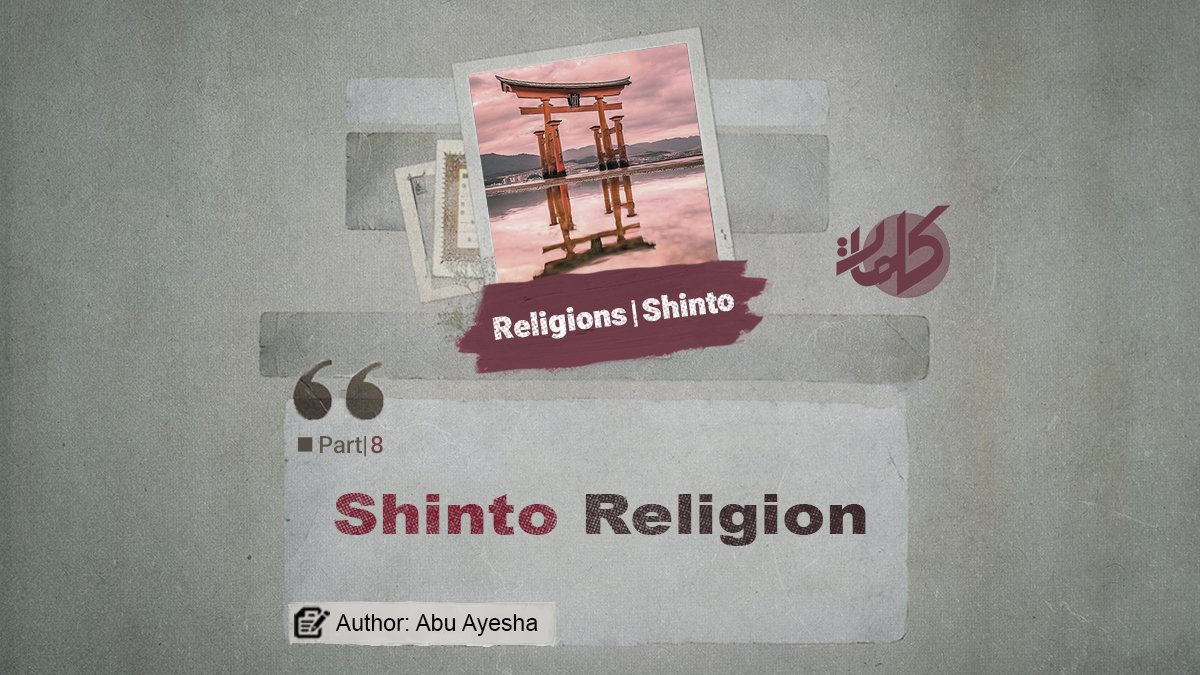Author: Abu Ayesha
Shinto Religion (Part Eight)
The Hiding of the Goddess Amaterasu in the Heavenly Cave
Amaterasu was so horrified by the death of her maiden attendant that she hid herself in a cave, and the earth fell into eternal darkness [since the Japanese considered Amaterasu the symbol of the sun, her departure brought darkness and the eclipse of the sunlight]. The gods became distressed and gathered to find a solution. A wise kami knew that the best trick to bring Amaterasu out of the cave was to hold a celebration. Therefore, the gods planted a sacred sakaki tree outside the cave (believed to be the dwelling of the divine spirit) and hung sacred jewels from its branches. They also wove a thick rope of straw and made a mirror to entice Amaterasu to come out of the cave. A rooster was also created so that morning would arrive.
A goddess named Uzume began dancing on an overturned wooden tub, striking it with her feet so that loud resonant sounds echoed from it… The gods burst into cheering, clapping, and shouting. Inside the cave, Amaterasu was astonished by the noise of the gods’ merrymaking. Out of curiosity, she slightly opened the cave door and peered out to see the cause. A god immediately held up the mirror before her, and Amaterasu saw a beautiful face in it. She did not recognize herself and was momentarily dazzled. A strong god seized the opportunity, flung the cave door wide open, and led her outside. Another god tied the rope across the cave entrance so that Amaterasu could not return inside. The world was once again filled with light.[1]
Amaterasu’s Gaze upon the Earth
According to their belief, after the appearance of Amaterasu, a strange turmoil arose on earth and there was a need for a god to look upon it. Therefore, Amaterasu cast her gaze upon it, the disorder was lifted, and a new order returned to the earth.“After several years, one day the Sun Goddess Amaterasu, from the heights of the heavens, looked down upon the earth and observed that upon the islands before her, much turmoil and great disorder prevailed, and that one of the sons of the storm god ruled over that land. From this, she became saddened and distressed, so she commanded her grandson named Ninigi to descend from the heavens to the earth, go to those islands, and rule over them on her behalf. The words that the Sun Goddess spoke to her grandson are part of the sacred prayers of the Japanese people, and even today every young child has memorized them and repeats them.”[2]
Of course, we did not see the need to mention and recite these prayers; therefore, we refrained from including them.
When examining the religions of the world, especially non-divine religions, we realize that such fabricated superstitions and myths exist that one becomes deeply astonished and sometimes disturbed upon hearing and reading them. Of course, these myths and legends in the Shinto religion are more numerous than in other religions; because these people grew up with such legends and became accustomed to them from the very beginning. Even today, they raise their children with the same superstitions and myths, teaching them their forms of worship through these tales.“In the Shinto religion, superstitions exist more than in any other faith. The knowledge of good and evil was sought through burning deer bones or turtle shells and studying the cracks on the turtle’s shell. In this way, the destiny of a person’s future life would become clear, and likewise the times of travel, marriage, and so on were determined by these ceremonies. Since the Japanese people and followers of this religion consider themselves descendants of the deity, they believe they do not need detailed laws and commandments, and instead they rely on their own nature for guidance. The religious center of Shinto is the city of Ise, known as the city of temples because it is full of shrines.[3] Another city named Nara has a similar status. The ‘Temple of a Thousand Buddhas’ in Japan is famous, containing countless statues of deities in various forms. Indeed, many temples exist in cities and villages throughout Japan. In 1945, emperor-worship was abolished in Japan; but still, many simple-minded people remain attached to this belief.”[4]
The Influence of Amaterasu on Ancient and Contemporary Art
Throughout history, Amaterasu has inspired many forms of ancient and contemporary Japanese art. Her story has been reflected in literature, poetry, painting, and even performing arts such as Noh and Kabuki theater. The myth of the “Heavenly Cave” is one of the most famous and frequently retold, serving as a symbol of the triumph of light over darkness and order over chaos.
Beyond literature and painting, Amaterasu has also inspired architectural designs and decorations that symbolize the balance between spirituality and materiality. The arts inspired by Amaterasu form an essential part of Japan’s cultural identity.[5]
Overall, this kami (Amaterasu) has been extremely important and vital in the material and spiritual life of the Japanese people, always serving as a source of inspiration and creativity. The Japanese have never forgotten her place throughout history, and she has always been remembered and respected.
Critique and Analysis
Although presenting these accounts may not be very important for someone who merely seeks basic information about this religion and its beliefs, the following point is crucial: by reading and studying these stories, we realize how the Japanese people—especially those who believe in such myths—have taken misguided paths and followed superstitious practices within their faith. Practices that, if one possesses even a small amount of sound reason, are far removed from comprehension and rational belief; ideas that are far from intellect and insight, which no rational human can possibly accept.
For example: how is it possible that a deity could be born from someone’s left eye? How can there be over eight million gods on a few small islands?
To summarize the matter of Shintoism, as one author put it: Shintoism is a “mythological religion.” Therefore, its followers’ relationship with their beliefs stems neither from common reason nor from divine revelation [revelation which is entirely light, wisdom, and guidance, leading humans toward success and salvation, and rescuing them from superstitions, worship of myths, and fabricated tales]. So how can a religion that originates neither from reason nor revelation be useful and effective? How can it save its followers from deviation?
Almighty God sent prophets (peace be upon them) and heavenly scriptures so that they might rescue humanity from superstitions, polytheism, and innovations. This religion, in contrast to all divine religions, calls people toward accepting superstitions, myths, and the worship of things that the Almighty has placed at the service of humankind, making them symbols of His power in this world.
Continues…
Previous Part / Next Part
References:
[1] Yusa, Michiko, Japanese Religions, trans. Hasan Afshar, First Edition, 2003 (1382 SH), p. 27.
[2] John Noss, A History of World Religions, trans. Ali Asghar Hekmat, 3rd edition, 1975 (1354 SH), Franklin Publishing Institute, p. 279.
[3] The discussion of temples, shrines, and their numbers will be mentioned in the next section of this study, God willing.
[4] Moballeghi Abadani, Abdullah, The History of Religions and Sects of the World, vol. 1, n.d., pp. 110–111.
[5] Website: Al-Majal, Author: Diane Abdellatif, Article Date: 2021, Title: “The Japanese Myth of Amaterasu: How the Sun Goddess Brought the World out of Darkness.”



